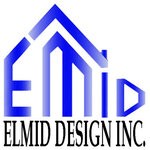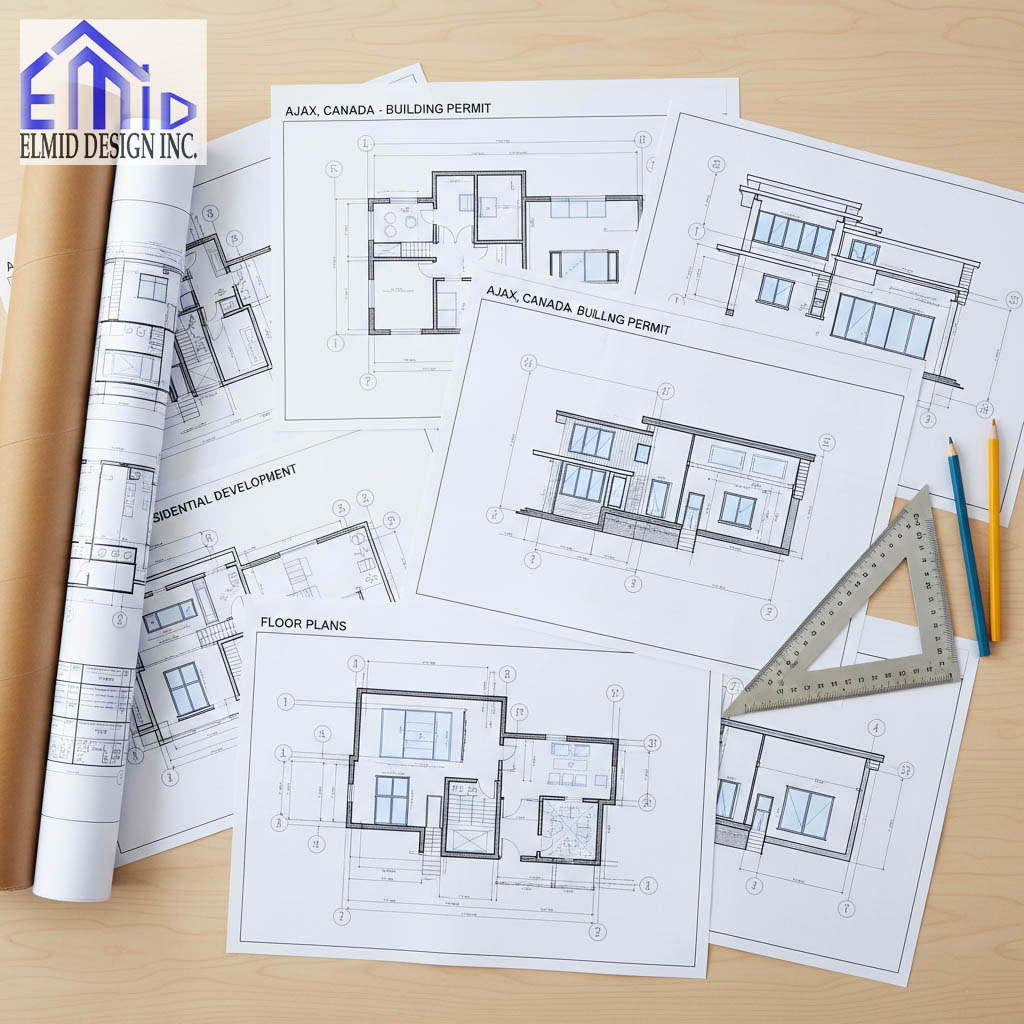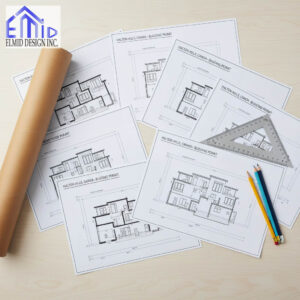The demand for multiplex permit drawing Ajax services continues to rise as more homeowners and investors search for ways to add legal multi-unit living spaces to their properties. Ajax continues to grow quickly, and with rising rental demand, multiplex conversions have become a practical way to increase housing supply. However, the process of getting a multiplex approved in Ajax can feel complicated because the town follows strict building code rules, zoning limits, and technical drawing requirements. Many applicants submit incomplete or unclear drawings, which leads to long delays and repeated review cycles. This guide explains the entire process in simple language so you can understand the steps involved and learn why professional drawings matter. Each section walks you through important planning, design, and safety requirements that help your multiplex move through Ajax’s system more smoothly.
Meaning of Multiplex Permit Drawing Ajax
A multiplex permit drawing Ajax is a complete set of architectural and engineering documents that show how a building will be converted or constructed into multiple legal units. These drawings include layout plans, structural details, site plans, fire safety features, mechanical systems, and building code information. Ajax staff review these documents to confirm that the proposed work follows the Ontario Building Code and all local bylaws. Drawings that are unclear or missing key information slow down the process and require revisions. Proper drawings help the reviewer understand the project quickly and allow the approval to move forward without unnecessary delays.
Why Multiplex Projects Are Increasing in Ajax
More property owners are seeking multiplex permit drawing Ajax services because Ajax continues to attract new residents who need a wider range of housing options. Multiplex units help meet this demand by creating extra rental spaces within existing neighborhoods. Homeowners choose multiplex projects to increase property value and generate a steady income stream, while investors see multiplex conversions as a long-term financial opportunity. Ajax encourages legal housing growth but enforces strict rules to protect safety and neighborhood character. As the number of applications increases each year, well-prepared drawings become more important to avoid delays during review.
Reviewing Zoning Before Starting the Design
Zoning is a major factor in every multiplex permit drawing Ajax project because it determines what you can legally build. Ajax’s zoning bylaws define the number of units allowed, building height limits, parking requirements, lot coverage, and setbacks. Designing a multiplex without checking zoning results in costly redesigns. Some neighborhoods already allow multi-unit homes, while others require a minor variance to proceed. Designers typically begin with a zoning review to understand what is possible on the property. Confirming zoning early helps owners avoid surprises and ensures the design matches the town’s requirements.
Required Drawing Types for Multiplex Permits
A complete multiplex permit drawing Ajax package includes several coordinated drawings that show the full scope of the project. Floor plans outline room layouts and circulation. Elevations show exterior appearances. Sections display vertical dimensions and structural relationships. Site plans show parking, setbacks, grading, and drainage. Structural drawings detail load-bearing elements and reinforcements. Mechanical, electrical, and plumbing drawings show how systems support each unit safely. Every document must meet the Ontario Building Code and Ajax’s submission standards. A complete set of clear drawings helps reviewers understand the project and reduces the need for revision requests.
Structural Engineering Requirements in Ajax
Structural engineering forms a critical part of a multiplex permit drawing Ajax because many multiplex conversions involve modifying load-bearing walls, joists, beams, or foundations. Engineers inspect the structure to confirm whether reinforcements are needed. When upgrades are required, the engineer prepares stamped structural drawings that guide safe construction. Ajax requires these documents whenever structural changes occur. Professional engineering support protects the property from future issues and ensures the building can support the new layout. Firms like Elmid Design Inc, which hold a Certificate of Authorization from Professional Engineers Ontario, prepare these engineering components to maintain safety and compliance.
Fire Safety and Unit Separation Requirements
Fire safety is one of the most important aspects of any multiplex permit drawing Ajax because multi-unit buildings must protect residents from smoke and flame spread. The Ontario Building Code requires fire-rated walls, fire-resistant ceilings, interconnected alarms, carbon monoxide detectors, and sealed mechanical penetrations. Drawings must show these features with clear details so reviewers can confirm code compliance. Improper or missing fire separation often leads to long delays because the city cannot approve unsafe layouts. Including complete fire safety details early supports smooth approvals and creates safer living conditions for future tenants.
Mechanical and HVAC Planning for Multiplex Homes
Mechanical planning is an essential part of a multiplex permit drawing Ajax because heating, cooling, and ventilation systems must serve multiple units reliably. Designers calculate airflow needs, heating loads, and cooling requirements for each unit. The Ontario Building Code sets strict ventilation standards that must be followed. Proper mechanical design helps maintain indoor air quality, prevent moisture problems, and keep each unit comfortable year-round. Ajax reviews mechanical details to confirm safety and energy efficiency. Clear documentation also helps contractors install the correct systems without confusion during construction.
Plumbing and Electrical System Requirements
Plumbing and electrical systems become more complex when multiple units are added, which is why they form a key part of every multiplex permit drawing Ajax submission, plumbing plans must show drainage, water supply, venting, and fixture locations. Electrical plans must show panel sizes, wiring distribution, and circuit loads. Some properties require service upgrades to support the increased demand. Ajax reviews these systems closely because they affect safety and long-term performance. When plumbing and electrical drawings are complete and clear, inspectors can verify installation quickly and reduce delays during construction.
Parking Requirements and Site Layout Planning
Parking and site layout influence the approval of every multiplex permit drawing Ajax because the town sets specific minimum parking requirements based on unit counts. Site plans must show driveway access, parking locations, walkways, elevations, and grading patterns. Ajax also requires proper drainage to prevent water from pooling around the building or flowing onto adjacent properties. Good site planning improves safety and accessibility for residents and allows the city to confirm the design respects neighborhood standards. A well-prepared site plan strengthens the permit submission and reduces the chance of review problems.
Importance of Detailed and Accurate Drawings
Detailed and accurate drawings are essential for a strong multiplex permit drawing Ajax submission because they allow reviewers to understand the project without confusion. Drawings that contain errors, missing notes, or vague measurements lead to revision requests that slow the approval process. Professionals use quality control steps to ensure consistency across structural, mechanical, and architectural drawings. Accurate drawings also help contractors follow the intended design, reducing mistakes during construction. High-quality documentation supports a smooth review cycle and lowers the risk of future building issues.
Common Challenges Applicants Face
Many homeowners experience challenges during the multiplex permit drawing Ajax process because the rules can feel overwhelming at first. Zoning limitations, fire safety requirements, mechanical planning, and structural upgrades require specialized knowledge. Some applicants attempt the process on their own but find that the drawings do not meet Ajax’s standards. These mistakes lead to delays, extra costs, and frustration. Working with experienced designers and engineers helps prevent these problems and ensures the drawing package meets all technical requirements. Professional guidance supports faster approvals and safer construction.
Role of Professional Designers and Engineers
Professional designers and engineers play a crucial role in every multiplex permit drawing Ajax package. Designers understand zoning bylaws, building code requirements, and layout efficiency. Engineers verify structural integrity, mechanical performance, and fire safety measures. Their combined expertise helps create drawings that meet the town’s expectations and support safe construction. Elmid Design Inc, authorized by Professional Engineers Ontario, provides this level of technical support and ensures that all drawings remain accurate and compliant. Professional involvement improves project reliability and increases the chance of first-round approval.

Digital Submission Requirements in Ajax
Digital submissions play an important role in the multiplex permit drawing Ajax process because they allow the town to review documents efficiently. Drawings must be formatted clearly, organized in the correct sequence, and labeled so each page can be understood without confusion. Scaled PDFs ensure that reviewers can read all measurements and notes. Proper file naming also helps maintain order during the review. Digital submissions reduce printing delays and make revisions easier to upload. When drawings are clean and easy to navigate, the approval process moves faster and avoids unnecessary back-and-forth communication.
Inspection Stages After Approval
After the permit is approved, construction must follow the multiplex permit drawing Ajax documents exactly because inspectors check each stage for compliance. Inspections usually cover framing, insulation, plumbing rough-ins, electrical rough-ins, fire separations, mechanical systems, and final completion. Inspectors compare on-site work with the approved drawings to confirm that every detail matches the design. If something differs, corrections may be required before work continues. Clear drawings guide contractors and help inspectors complete reviews quickly. Proper coordination between owners, designers, and contractors improves project efficiency and reduces the risk of delays.
Frequent Errors That Slow Down Approval
Many applications face delays because the multiplex permit drawing Ajax package contains errors that raise questions during review. Missing structural notes, unclear dimensions, incorrect zoning assumptions, or incomplete mechanical details often cause the town to request revisions. Some submissions include outdated drawings that no longer match the intended renovation. Others fail to address parking, grading, or fire separation. These issues slow progress and increase costs. Submitting a complete, coordinated, and accurate drawing package helps prevent unnecessary delays and shows reviewers that the project is planned responsibly.
Importance of Licensed Designers and Engineers
Licensed designers and engineers strengthen every multiplex permit drawing Ajax submission because they understand complex code rules that homeowners often miss. Designers create functional layouts that follow zoning limits and building code guidelines. Engineers review structural loads, mechanical systems, and fire protection requirements. Their coordinated work helps reduce errors and supports safe construction. Ajax reviewers trust professionally prepared documents because they follow established standards and present information clearly. Professional involvement leads to smoother communication, faster approvals, and higher-quality final results for homeowners and investors.
Structural Reinforcement Needs in Multiplex Conversions
Structural reinforcement is a critical part of many multiplex permit drawing Ajax packages because converting a home into multiple units increases loads on floors, beams, and supporting walls. Engineers inspect the structure to determine whether reinforcement is required. If upgrades are needed, they design new beams, posts, or supports to improve stability. These details must appear in the structural drawings so contractors know what to install. Ajax reviews structural documentation closely to ensure the building can handle the additional weight safely. Addressing reinforcement early helps prevent construction delays and long-term structural issues.
Ventilation and Indoor Air Quality Requirements
Ventilation is an important component of every multiplex permit drawing Ajax because multiple units require healthy airflow to maintain comfort and safety. The Ontario Building Code includes strict ventilation rules that guide fresh air delivery, exhaust systems, and equipment sizing. Designers calculate airflow rates for each unit and place mechanical equipment where it functions most effectively. Good ventilation reduces humidity problems, prevents stale air, and improves indoor comfort. Ajax reviews mechanical drawings to confirm compliance. Clear notes and diagrams help ensure the system is installed correctly during construction and performs reliably long-term.
Accessibility Considerations for Multi-Unit Homes
Accessibility standards shape part of every multiplex permit drawing Ajax because certain projects must support residents with mobility challenges. Designers review door widths, hallways, bathrooms, and entry paths to confirm which accessibility rules apply. Adding these features early prevents expensive redesigns during construction. Ajax checks accessibility elements to ensure compliance with provincial standards and safe living conditions. Accessible design also increases long-term property value because it appeals to a wider range of tenants. Proper planning ensures the building remains inclusive, functional, and safe for all residents.
Drainage and Exterior Grading Planning
Drainage and grading form key components of a multiplex permit drawing Ajax because improper water flow can damage the building and surrounding properties. Site plans must show how water drains away from the structure and how grading protects basements and foundations from moisture risks. Basement units require extra attention to ensure drainage systems remain reliable. Ajax reviews grading and drainage designs carefully to confirm compliance with neighborhood standards. Clear site planning prevents water pooling, landscape erosion, and long-term moisture problems. Including accurate grading details in the drawings helps contractors shape the site correctly during construction.
Energy Efficiency Expectations in Ajax
Energy efficiency is an essential part of every multiplex permit drawing Ajax because multi-unit homes must meet specific performance standards set by the Ontario Building Code. These expectations include insulation values, window ratings, air sealing, and mechanical efficiency. Designers prepare energy compliance notes while engineers verify that mechanical systems meet required performance levels. Efficient construction reduces energy costs for tenants and supports long-term comfort. Ajax checks energy details to encourage sustainable building practices across the community. Meeting these requirements strengthens the building’s durability and improves overall performance.
Financial Benefits of Multiplex Conversions
Multiplex conversions offer strong financial benefits because legal units generate consistent rental income and increase market value. A complete multiplex permit drawing Ajax package proves that the project meets zoning limits, building code rules, and safety standards. Buyers prefer homes with approved units because they have fewer legal risks and greater income potential. Well-designed layouts, efficient mechanical systems, and strong structural planning help attract reliable tenants and improve long-term property performance. These financial advantages explain why many Ajax homeowners choose to convert their properties into multiplex homes.
Basement Conversions in Multiplex Projects
Basement conversions play a major role in the multiplex permit drawing Ajax process because they allow homeowners to add new legal units without expanding the building footprint. However, basement units must follow strict rules for ceiling height, exits, ventilation, moisture protection, and window sizes. Designers examine structural conditions to determine whether underpinning or new beams are required. Engineers evaluate the foundation and framing to confirm safety before changes are made. Including detailed basement information in the drawings helps Ajax reviewers understand how the design meets building code requirements. Clear basement planning reduces delays and improves approval success.
Soundproofing Requirements for Multi-Unit Homes
Soundproofing is an essential element in a multiplex permit drawing Ajax because noise can travel easily between units and affect tenant comfort. The Ontario Building Code sets specific sound transmission ratings that walls and floors must meet. Designers select materials and construction assemblies that support these ratings, while engineers ensure the structure can carry the added layers. Proper soundproofing improves privacy and reduces tenant complaints. Ajax reviews these details carefully to confirm noise control measures meet required standards. Clear soundproofing documentation helps contractors install the correct assemblies without confusion during construction.
Fire Protection Measures for Multiplex Safety
Fire protection is one of the strongest requirements in any multiplex permit drawing Ajax because it protects residents and reduces risk during emergencies. Drawings must show fire-rated walls, protected ceilings, sealed penetrations, and safe exit routes. Interconnected alarms and carbon monoxide detectors must be placed in proper locations. Mechanical and plumbing penetrations require fire-stopping systems that maintain the integrity of fire barriers. Ajax examines these details closely because missing or unclear fire protection features delay approval. Clear documentation ensures safe construction and supports smooth inspections throughout the building process.
Structural Improvements for Older Ajax Properties
Many multiplex permit drawing Ajax submissions involve older homes that need structural upgrades before adding new units. Older framing may not support additional loads or modern safety requirements. Engineers inspect beams, joists, foundations, and load paths to determine whether reinforcements are required. Improvements may include new beams, posts, or floor supports. Designers adjust layouts to align with these structural needs while maintaining code compliance. Clear structural documentation helps reviewers understand the changes and ensures the home remains safe after conversion. These upgrades improve long-term building performance.
Moisture Protection and Waterproofing Strategies
Moisture protection is an important part of multiplex permit drawing Ajax because water intrusion can damage building materials and create unsafe living conditions. Designers study how water flows across the property and include grading plans that direct water away from the foundation. Basement units require reliable waterproofing systems to prevent leaks and mold. Ajax reviews these details to confirm drainage and waterproofing measures meet safety standards. Proper moisture management improves indoor air quality, reduces structural risk, and creates healthier environments for future tenants. Clear details also help contractors follow the correct installation methods.
Mechanical Capacity and System Upgrades
Mechanical systems must be capable of serving multiple units effectively, making them a significant part of any multiplex permit drawing Ajax. Designers calculate heating, cooling, and ventilation loads to confirm whether existing systems can support the extra demand. Many multiplex projects require new mechanical equipment, improved duct layouts, or dedicated ventilation units for each suite. Ajax reviews these details to ensure energy efficiency and safety are maintained. Proper mechanical design improves indoor comfort and reduces long-term energy costs. Accurate mechanical drawings help installers complete work correctly and pass inspections with minimal corrections.
Benefits of Working With Industry Professionals
Working with experienced professionals strengthens every multiplex permit drawing Ajax package because designers and engineers understand zoning limits, code rules, and technical requirements. Designers create practical layouts that follow building and zoning guidelines. Engineers verify structural, mechanical, and fire safety measures. Elmid Design Inc, authorized by Professional Engineers Ontario, provides this level of professional support and ensures drawings remain compliant and accurate. This expertise reduces delays, improves approval timelines, and leads to safer construction. Professional guidance helps owners avoid costly redesigns and maintain confidence throughout the process.
How Multiplex Homes Support Ajax’s Growth
Multiplex homes support Ajax’s long-term growth by increasing housing supply and offering affordable options to families, students, and workers. These units help the town expand responsibly without adding pressure on undeveloped land. A complete multiplex permit drawing Ajax package ensures each unit meets zoning, safety, and performance standards. Well-designed multiplex developments strengthen neighborhoods, support local businesses, and improve long-term property value. These benefits make multiplex housing an important part of Ajax’s strategy for sustainable growth and community development.
Long-Term Financial Benefits of Multiplex Conversions
Multiplex conversions continue to gain popularity because they offer strong financial benefits for homeowners and investors. Legal units generate stable rental income and attract buyers seeking flexible housing options. A complete multiplex permit drawing Ajax package documents safe construction and compliance with all rules. Buyers value homes with approved units because they reduce legal risks and increase potential revenue. Good layouts, efficient mechanical systems, and proper soundproofing help attract long-term tenants and improve building performance. This financial stability makes multiplex conversions a smart investment in Ajax’s housing market.
FAQ
What drawings are required for a multiplex permit in Ajax?
A multiplex permit drawing Ajax package usually includes floor plans, elevations, sections, site plans, structural drawings, mechanical layouts, plumbing details, electrical plans, and building code notes. These documents help Ajax confirm compliance with zoning and safety requirements.
Do I need engineering for a multiplex conversion in Ajax?
Most multiplex projects require engineering because structural modifications, mechanical changes, and fire protection features must meet Ontario Building Code rules. Engineers provide stamped drawings that confirm the design meets safety standards.
How long does the permit process take in Ajax?
Timelines depend on project complexity and drawing quality. A complete and well-organized multiplex permit drawing Ajax package moves faster because it reduces the need for revisions or clarification requests.
Can I convert my basement into a legal multiplex unit?
Yes, basement units can be approved when the design meets Ajax’s requirements for ceiling height, egress windows, moisture control, ventilation, and structural stability. Clear drawings help confirm compliance.
What increases the cost of a multiplex conversion?
Costs rise when structural reinforcement, mechanical upgrades, fire protection improvements, or complex layout changes are needed. A detailed multiplex permit drawing Ajax submission helps identify these needs early and reduces unexpected expenses.

Why Ajax Homeowners Trust Elmid Design Inc
Elmid Design Inc is a licensed engineering firm with a Certificate of Authorization from Professional Engineers Ontario, providing dependable structural and permit drawing services for multiplex projects across Ajax. The company prepares accurate, code-compliant designs that support safe construction, smooth approvals, and long-term project performance. With strong technical expertise and clear documentation, Elmid Design Inc helps homeowners and investors complete multiplex conversions confidently and efficiently.
Geographic Locations That We Service:
Our Licensed Professional Engineers specializing in Engineered Site Grading Plans offer the best-engineered site grading plan, lot grading and erosion plan, and drainage plan to obtain site plan approval and building permits in Ontario, including a wide range of municipalities. Each area boasts unique features and requirements, making our tailored approach essential for success.
Toronto and Surrounding Areas
In the vibrant heart of Ontario, we service Toronto (City of Toronto) and surrounding areas. Additionally, we cover Oshawa (City of Oshawa), Pickering (City of Pickering), and Clarington (Municipality of Clarington). Furthermore, our expertise extends to Ajax (Town of Ajax), Whitby (Town of Whitby), Brock (Township of Brock), Scugog (Township of Scugog and Uxbridge (Township of Uxbridge).
Halton Region
Moving to the Halton Region, our services encompass Burlington (City of Burlington) and Halton Hills (Town of Halton Hills). Also included are Milton (Town of Milton) and Oakville (Town of Oakville).
Peel Region
In the Peel Region, we provide services in Brampton (City of Brampton), Mississauga (City of Mississauga), and Caledon (Town of Caledon).
York Region
Our services in the York Region cover Vaughan (City of Vaughan), Aurora (Town of Aurora), and East Gwillimbury (Town of East Gwillimbury). We also cater to Georgina (Town of Georgina), Markham (City of Markham), Newmarket (Town of Newmarket), Richmond Hill (City of Richmond Hill), Whitchurch-Stouffville (Town of Whitchurch-Stouffville), King (Township of King), and Bradford-West Gwillimbury (Town of Bradford-West Gwillimbury). Each municipality here offers a distinct setting, requiring our specialized approach.
Other Southern Ontario Cities and Towns
We also serve many other cities and towns in Southern Ontario. These include Hamilton (City of Hamilton), St. Catharines (City of St. Catharines), Niagara on the Lake (Town of Niagara on the Lake), Brant (County of Brant), Cambridge (City of Cambridge), Kitchener (City of Kitchener), Waterloo (City of Waterloo), and Woodstock (City of Woodstock). Furthermore, we operate in Guelph (City of Guelph), Centre Wellington (Township of Centre Wellington), Shelburne (Town of Shelburne), Orangeville (Town of Orangeville), New Tecumseth (Town of New Tecumseth), Essa (Town of Essa), Collingwood (Town of Collingwood), Wasaga Beach (Town of Wasaga Beach), Barrie (City of Barrie), Midland (Town of Midland), Orillia (City of Orillia), Ramara (Town of Ramara), Minden Hills (Town of Minden Hills), North Kawartha (Town of North Kawartha), Kawartha Lakes (City of Kawartha Lakes), Peterborough (City of Peterborough), Selwyn (Town of Selwyn), and Brighton (Municipality of Brighton).




